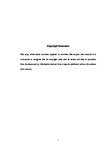Factors that impact Pseudo-nitzschia spp. occurrence, growth, and toxin production
| dc.contributor.supervisor | ROWLAND, STEVEN | |
| dc.contributor.author | DOWNES-TETTMAR, NAOMI | |
| dc.contributor.other | School of Geography, Earth, and Environmental Sciences | en_US |
| dc.date.accessioned | 2013-08-05T07:58:24Z | |
| dc.date.available | 2013-08-05T07:58:24Z | |
| dc.date.issued | 2013 | |
| dc.identifier | 332890 | en_US |
| dc.identifier.uri | http://hdl.handle.net/10026.1/1588 | |
| dc.description.abstract |
This work investigates, for the first time, the Pseudo-nitzschia (PN) dynamics in the western English Channel (L4) and the environmental factors impacting on domoic acid (DA) production in these waters. This is combined with laboratory studies examining key environmental factors and the multifactorial impact of multiple macronutrient and micronutrient availability on PN growth and DA production. An LC-MS method was established, optimised, and compared with ELISA for the accurate and reproducible extraction and determination of particulate and dissolved DA. The method was used to measure the seasonal variation in DA at L4 during 2009 and this was compared to PN seasonal abundance and diversity. Three groups a P. delicatissima-group, a P. seriata-group, and a P. pungens/multiseries-group were identified and were found to have different ecological distributions with the latter two groups significantly correlating with DA concentration. Macronutrients, in combination with other environmental factors, were found to influence PN populations at L4. Multifactorial laboratory culture experiments investigating the availability of nitrate, phosphate, and silicate, confirmed that the interrelatedness of all these nutrients significantly affected the growth, decline, and DA production of P. multiseries, and highlight the importance of both phosphate and silicate availability for DA production. When the impacts of both macronutrient (phosphate and silicate) and micronutrient (iron and copper) availability were investigated, limited growth and DA production was observed in P. multiseries cultures. Results revealed the complexity and interrelationship of factors affecting both PN growth and DA production. Furthermore, molecular methods were developed to elucidate the PN species present from 2009 Lugol’s-preserved L4 samples. DNA was successfully extracted and amplified from these samples which had been stored for up to 2 years. Initial sequence analysis identified the rbcL DNA marker as an informative site for future work with a number of L4 sequences closely relating to different Pseudo-nitzschia spp. | en_US |
| dc.language.iso | en | en_US |
| dc.publisher | University of Plymouth | en_US |
| dc.subject | Domoic acid | en_US |
| dc.subject | Algal Toxins | en_US |
| dc.subject | Western English Channel | en_US |
| dc.subject | Time Series | en_US |
| dc.subject | Pseudo-nitzschia | en_US |
| dc.title | Factors that impact Pseudo-nitzschia spp. occurrence, growth, and toxin production | en_US |
| dc.type | Thesis | en_US |
| plymouth.version | Full version | en_US |
| dc.identifier.doi | http://dx.doi.org/10.24382/1419 | |
| dc.identifier.doi | http://dx.doi.org/10.24382/1419 |
Files in this item
This item appears in the following Collection(s)
-
01 Research Theses Main Collection
Research Theses Main


